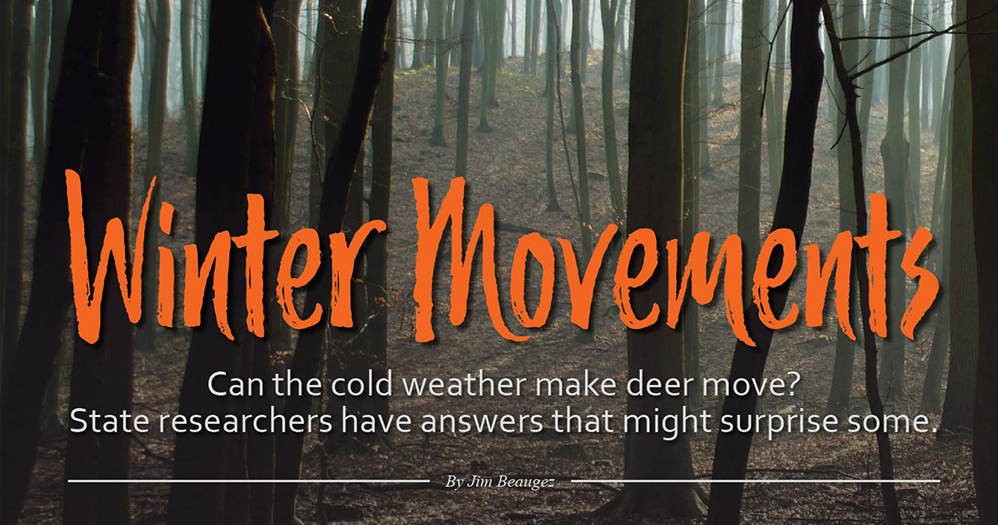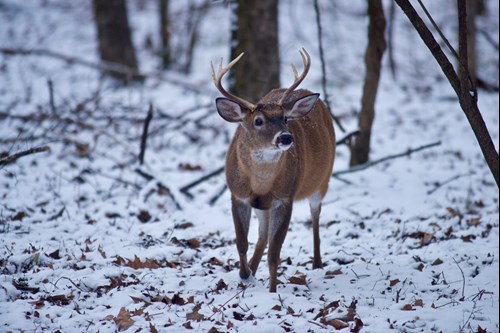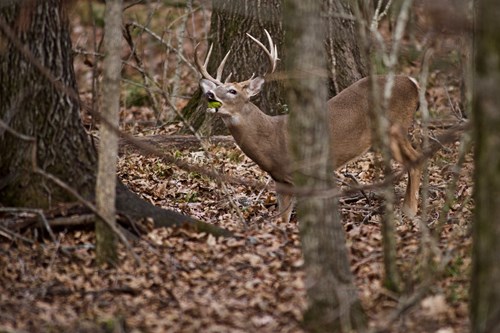Winter Movements
11/7/2018 1:52:26 PM
By Jim Beaugez

Deer hunters run a close second to anglers in telling stories of their adventures and victories, delivering moment-by-painful-moment recollections of the ones that got away.
For hunters, descriptions of setting, timing, and weather are key to the plot. There cannot be a more argued subject among deer hunters than which one of those factors will put a monster buck in the right place at the right time. A vexing question is: What makes a deer move?
Virtually all deer hunters experience days when deer seem to be moving more than usual. You see them and, if patient and skilled, you are able to bring home a buck.
Or perhaps the luck does not fall your way. But why?
Was it a windy day when that trophy buck stepped into the clearing? Did a cold front push through the night before? Was a slow, cold rain falling? Was the barometric pressure dipping or rising?
Hunters can drive themselves crazy trying to unlock the secrets of what can make deer move. The internet is full of blogs, articles, and message boards of hunters sharing their theories.
Weather or not?
The likely answer, though, is that these “magic days,” as Mississippi State University (MSU) biologist Bronson Strickland describes them, are more a result of happenstance than weather patterns or external events.
“What is it about some of those days that’s just like deer magic?” Strickland said. “You drive down the road (and) might take the same route every single day, and one day out of the week you see 20 deer, and all the other days you see zero or one.
“It just so happens it is 10 degrees cooler (that night) than it was the previous night, and we saw three times as many deer…so we make this association that it had to be the temperature. If you had a completely randomized and replicated experiment, all over the landscape, that might not have been the case at all. You were at the right place at the right time.”
Humans often have the urge to bring order to chaos, which leads us to rationalize and draw relationships between events where there is no cause and effect. In a hunter’s attempt to apply logic, it is easy to create a false narrative.
Strickland, a wildlife ecology and management professor at MSU’s Deer Lab, has studied subjects such as the impact of antler restrictions and supplemental feeding on deer populations. He also co-authored a study on deer movement with MSU colleague Stephen Demarais and other researchers, where they fitted bucks and does with GPS collars to determine how the environment might influence movement.
“I can’t sit here and say (weather) has zero influence,” says Strickland. “All we can say is when we put a GPS tracker on a deer, we know where it moves and how much it moves and when it moves every single day. When you compile it over a number of deer, over a season, the effects aren’t nearly as strong as you might think they would be.”

Certain influences
There were some surprises in the subtle ways weather affected deer movement, though.
HUMIDITY: Most hunters would not peg humidity levels as a significant motivator for deer to move. Statistically, though, bucks in the study moved 25 percent more on days when the humidity was high.
BAROMETER: Mississippi Department of Wildlife, Fisheries, and Parks (MDWFP) Deer Program Coordinator William McKinley said, “(Deer) movement appears to increase when barometric is changing.” Strickland’s study agrees. It found that extremely high barometric pressure did correlate to increased buck movement in the wintertime, but there are caveats.
“I’m talking not when the pressure was a little bit more than normal,” Strickland said. “The barometric pressure had to change (to) double the normal amount, or double the amount of variation, so it had to be a very, very big swing. (But) it did double the amount of deer movement (in regard to) distance they moved during the day.”
WIND: Researchers also saw deer movements change with fluctuations in wind velocity. Late in the afternoon when there was no wind, deer moved more than usual. Some hunters might be surprised that they saw the same effect at the other end of the spectrum, on days when the wind was howling.
“If you were heading out at 2 o’clock, and it is so windy that afternoon tree tops are blowing around, (and) it’s cold, do you go hunt?” Strickland asked. “A lot of people don’t see deer on really windy days because they don’t hunt on really windy days.”
Another benefit to hunting on days when the wind is strong and variable, he added, is that your scent could be diffused in the wind, making it more difficult for a deer to detect.

The food connection
In reality, most deer movement during hunting season, excluding rut activities, has to do with tending to everyday survival. All animals, including humans, will usually find a way to eat every day despite the weather. “What I try to emphasize to every person is that you have to think about a deer, and a deer has to fill his or her belly every single day,” Strickland says. “Typically they’re going to have two really big feeding bouts. Normally that’s in the morning, before dawn or at dawn or shortly after, and then normally late afternoon, (around) dusk and sunset.”
MDWFP biologist Adam Butler also cited the drive to find food but notes that cold weather can keep bucks on their feet as they forage for longer periods.
“When it is cold, they have to intake more food because they are burning more calories,” Butler said on a recent Mississippi Outdoors Radio program. “Therefore, they are going to be on their feet more. In other words, you are going to see more deer when it’s cold, generally speaking.”
Added Strickland, “They are driven by their stomach to eat. And what we see when we put radio collars on deer, or when we put GPS collars on deer, and we compare movement patterns, trying to relate it back to weather events, we see very little change, except at the extremes.”
Jim Beaugez is a freelance writer for Mississippi Outdoors









